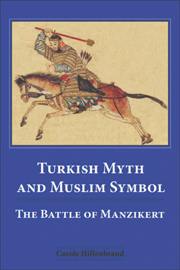Book contents
- Frontmatter
- Contents
- List of figures
- List of plates
- Acknowledgements
- Comment on transliteration and conventions used in the book
- Dedication
- Part 1 Medieval Muslim interpretations of the battle of Manzikert
- 1 Introduction
- 2 The twelfth-century accounts of the battle of Manzikert
- 3 The thirteenth-century accounts of the battle of Manzikert
- 4 The fourteenth- and fifteenth-century accounts of the battle of Manzikert
- 5 Writing the battle
- Part 2 The legacy of the battle
- Conclusion
- Appendix A The account of the battle of Manzikert by Michael Attaleiates, translated by Ruth Macrides
- Appendix B Translations of some other medieval Christian accounts of the battle of Manzikert
- Appendix C Other medieval Muslim accounts of the battle of Manzikert
- Bibliography
- Index
- Plate section
1 - Introduction
from Part 1 - Medieval Muslim interpretations of the battle of Manzikert
Published online by Cambridge University Press: 05 August 2013
- Frontmatter
- Contents
- List of figures
- List of plates
- Acknowledgements
- Comment on transliteration and conventions used in the book
- Dedication
- Part 1 Medieval Muslim interpretations of the battle of Manzikert
- 1 Introduction
- 2 The twelfth-century accounts of the battle of Manzikert
- 3 The thirteenth-century accounts of the battle of Manzikert
- 4 The fourteenth- and fifteenth-century accounts of the battle of Manzikert
- 5 Writing the battle
- Part 2 The legacy of the battle
- Conclusion
- Appendix A The account of the battle of Manzikert by Michael Attaleiates, translated by Ruth Macrides
- Appendix B Translations of some other medieval Christian accounts of the battle of Manzikert
- Appendix C Other medieval Muslim accounts of the battle of Manzikert
- Bibliography
- Index
- Plate section
Summary
The Battle of Manzikert was the most decisive disaster in Byzantine history.
Opening remarks
The first time the medieval Turks came to general notice outside the Middle East was in 1071, when news of an extraordinary military victory began to reach Europe. The second ruler of the Seljuq Turkish Muslim dynasty, Alp Arslan, a nomad from the steppes of Central Asia, is almost exclusively known outside the borders of Turkey as the victor at the famous battle of Manzikert in August 1071. In this battle he defeated the Byzantine emperor Romanus IV Diogenes, took him prisoner and then released him honourably.
Historians from the time of Gibbon onwards have traditionally seen this battle as the pivotal moment after which Byzantine Asia Minor was gradually to become Muslim Anatolia. Manzikert signalled the slow but inexorable decline both of Byzantium and of Christianity in Anatolia. In addition, modern Crusader historians have seen the battle of Manzikert as one of the factors which began to cause disquiet about the Muslim world in the minds of the Christian rulers in eleventh-century Europe. There was unease and fear at the growing power of the Turks on the eastern flanks of the ancient Christian empire of Byzantium and the infiltration of waves of nomadic Turks across the Anatolian plateau.
- Type
- Chapter
- Information
- Turkish Myth and Muslim SymbolThe Battle of Manzikert, pp. 3 - 25Publisher: Edinburgh University PressPrint publication year: 2007



